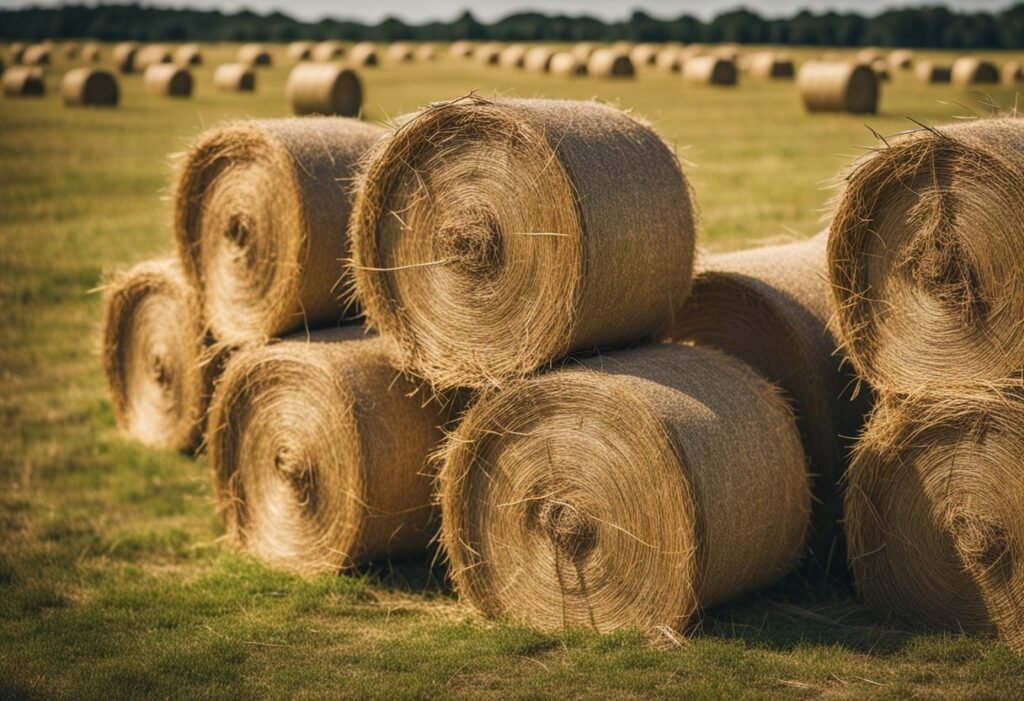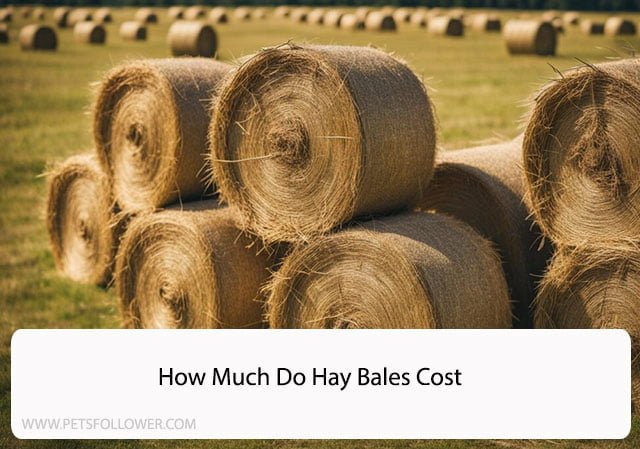Hay bales are a common sight in many rural areas, used for everything from feeding livestock to decorating for fall festivals. However, if you’re new to the world of hay bales, you may be wondering just how much they cost. The answer, as with most things, varies depending on a number of factors.

One of the biggest factors affecting the cost of hay bales is the type of hay being used. Alfalfa hay, for example, is typically more expensive than grass hay. The size of the bales can also impact the price, with larger bales generally costing more than smaller ones. Additionally, the location and availability of hay in your area can play a role in the cost.
Average Cost of Hay Bales
When it comes to purchasing hay bales, the cost can vary depending on several factors. These factors include the type of hay, the quality of the hay, and the location of the seller.
On average, a standard square bale of hay can cost anywhere from $3 to $10 per bale. This price can increase if the hay is of higher quality or if it is a specialized type of hay such as alfalfa.
Round bales, which are larger and typically used for feeding livestock, can cost anywhere from $30 to $100 per bale. Again, the price can vary depending on the type and quality of hay.
It’s important to note that the cost of hay can also fluctuate depending on the season and weather conditions. Droughts or other natural disasters can cause a shortage of hay, driving up the price.
Overall, it’s best to shop around and compare prices from different sellers before making a purchase. It’s also important to consider the quality of the hay and the needs of your livestock before making a decision.
Factors Affecting Hay Bale Prices
When it comes to buying hay bales, the price can vary depending on several factors. In this section, we will discuss the main factors that affect hay bale prices, including the quality of the hay, the region where it is produced, and the availability of Hay Bales For Sale in the market.
Type of Hay
The type of hay is one of the most significant factors that affect hay bale prices. Alfalfa hay, for example, is typically more expensive than grass hay due to its higher nutritional value. Similarly, Timothy hay is often more expensive than other types of grass hay due to its high demand.
Bale Size and Weight
The size and weight of the bale can also affect the price. Generally, larger bales are more cost-effective than smaller ones because they require less labor to produce. However, larger bales may also require specialized equipment to handle and transport, which can add to the cost.
Seasonal Variations
Hay prices can also vary depending on the season. During the growing season, hay is usually cheaper because there is an abundance of fresh hay available. However, during the winter months when hay is scarce, prices tend to increase.
Geographical Location
The location of the hay producer can also affect the price of hay bales. In areas where hay production is high, prices are usually lower due to increased competition. In contrast, areas with low hay production may have higher prices due to transportation costs.
Supply and Demand
Finally, supply and demand play a significant role in determining hay bale prices. When there is a high demand for hay and a limited supply, prices tend to increase. Conversely, when there is an oversupply of hay and low demand, prices tend to decrease.
In conclusion, hay bale prices can vary significantly depending on several factors, including the type of hay, bale size and weight, seasonal variations, geographical location, and supply and demand. It’s essential to consider these factors when purchasing hay to ensure that you’re getting a fair price.
Cost Comparison by Hay Type
Alfalfa Hay
Alfalfa hay is a popular choice for farmers because of its high protein content and nutrient density. However, it is also one of the more expensive types of hay. On average, a 50-pound bale of alfalfa hay can cost anywhere from $15 to $25. Prices may vary depending on the region, quality, and time of year.
Grass Hay
Grass hay is a more affordable option compared to alfalfa hay. It is lower in protein but still provides essential nutrients for livestock. Prices for a 50-pound bale of grass hay can range from $8 to $15. Again, prices may vary depending on the region and quality.
Mixed Hay
Mixed hay, as the name suggests, is a combination of both alfalfa and grass hay. It provides a good balance of nutrients and is a popular choice for farmers. Prices for a 50-pound bale of mixed hay can range from $12 to $20. As with the other types of hay, prices may vary depending on the region and quality.
When it comes to choosing the right hay for your livestock, it is important to consider both the cost and nutritional value. While alfalfa hay may be more expensive, it may be worth the investment for its high protein content. On the other hand, grass hay may be a more affordable option that still provides essential nutrients. Mixed hay can provide a good balance of both. Ultimately, the choice will depend on your specific needs and budget.
Buying in Bulk vs. Small Quantities
When it comes to purchasing hay bales, one important decision to make is whether to buy in bulk or small quantities. There are pros and cons to both options, and it ultimately depends on your specific needs and budget.
Bulk Purchases
Buying hay bales in bulk can often result in cost savings. Many suppliers offer discounts for large orders, and shipping costs may be lower per bale when buying in bulk. Additionally, if you have a large number of animals or need hay for a long period of time, buying in bulk can ensure that you have enough supply to last.
However, bulk purchases also require more storage space and may not be feasible for those with limited storage options. It’s important to consider the cost of storage and any additional equipment needed to handle large quantities of hay.
Small Quantities
For those with limited storage space or a smaller number of animals, purchasing hay bales in smaller quantities may be a better option. This allows for easier handling and storage, and can also be more cost-effective in the short term.
However, purchasing hay in small quantities may result in higher costs per bale. Additionally, if you have a larger number of animals or need hay for an extended period of time, you may need to make more frequent purchases, which can add up in terms of time and money.
Overall, the decision to buy hay bales in bulk or small quantities depends on your specific needs and budget. It’s important to weigh the pros and cons of each option and choose the one that best meets your needs.
Additional Costs to Consider
Delivery Fees
When purchasing hay bales, it is important to consider the cost of delivery. Depending on the distance of the delivery location, delivery fees can range from $50 to $200 or more. Some suppliers may offer free or discounted delivery for bulk orders, so it is important to inquire about any potential discounts.
Storage Expenses
Storing hay bales can also come with additional costs. If you do not have adequate storage space on your property, you may need to rent a storage unit. The cost of a storage unit can vary depending on the location and size, but typically ranges from $50 to $200 per month.
In addition to storage units, you may also need to purchase tarps or covers to protect the hay bales from moisture and weather damage. These can range from $20 to $50 per tarp.
It is important to consider these additional costs when budgeting for hay bales. By factoring in delivery fees and storage expenses, you can ensure that you are accurately estimating the total cost of your hay bale purchase. For larger transportation needs, you can get anything shipped on Shiply, ensuring a smooth and efficient delivery process.

Tips for Saving Money on Hay
When it comes to purchasing hay, there are a few things you can do to save money. Here are some tips:
- Buy in bulk: Purchasing hay in larger quantities can often result in a lower price per bale. Consider buying a larger quantity of hay if you have the storage space and the need for it.
- Shop around: Don’t settle for the first supplier you find. Research different suppliers and compare prices to find the best deal.
- Consider the type of hay: Different types of hay have different prices. Consider using a less expensive type of hay if it meets your horse’s nutritional needs.
- Buy during off-season: Hay prices tend to be higher during the winter months when demand is high. Consider purchasing hay during the off-season to save money.
- Check for quality: While it may be tempting to purchase the cheapest hay available, it’s important to ensure that the hay is of good quality. Poor quality hay can lead to health problems for your horse and end up costing you more in the long run.
By following these tips, you can save money on hay without sacrificing the quality of the hay your horse receives.
Frequently Asked Questions
What is the average price range for a bale of horse-quality hay?
The average price range for a bale of horse-quality hay can vary depending on the region and time of year. On average, you can expect to pay anywhere from $5 to $15 per bale.
How does the cost of hay vary between states like Florida and California?
The cost of hay can vary greatly between different states due to factors such as climate, transportation costs, and supply and demand. In general, hay tends to be more expensive in states with a higher cost of living, such as California, compared to states like Florida where the cost of living is lower.
What are the current costs associated with purchasing a bale of hay from Tractor Supply?
The current cost of purchasing a bale of hay from Tractor Supply can vary depending on the type of hay and the region. On average, you can expect to pay around $10 per bale for horse-quality hay.
How much would one expect to pay for a ton of hay on the current market?
The current market price for a ton of hay can vary depending on the type of hay and the region. On average, you can expect to pay anywhere from $150 to $300 per ton.
What are the expenses involved in baling hay per acre for farmers?
The expenses involved in baling hay per acre for farmers can vary depending on factors such as equipment costs, labor costs, and the cost of seed and fertilizer. On average, farmers can expect to spend anywhere from $50 to $150 per acre.
Can you provide an estimate for the longevity of a single hay bale when used for feeding?
The longevity of a single hay bale when used for feeding can vary depending on factors such as the quality of the hay, the storage conditions, and the feeding practices. On average, a single hay bale can last anywhere from a few days to a few weeks. It is important to monitor the hay regularly and discard any bales that appear moldy or spoiled.





